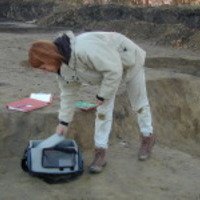
Karin Nys
Related Authors
Eric H Cline
The George Washington University
Juan Antonio Quirós Castillo
University of the Basque Country, Euskal Herriko Unibertsitatea
Ernst Pernicka
Universität Heidelberg
Philipp Wolfgang Stockhammer
Ludwig-Maximilians-Universität München
Enrico Cirelli
Università di Bologna
Michael Dietler
University of Chicago
Viktória Kiss
Hungarian Academy of Sciences
Michael Shanks
Stanford University
Alexander Fantalkin
Tel Aviv University
Leonardo García Sanjuán
Universidad de Sevilla
Interests









Uploads
Papers by Karin Nys
The motivation to use standardised shapes with fixed volume is multiple: (1) perfume marketers needed to be certain to buy uniform sets of very recognizable vessels with the required volumes to contain their produce; (2) customers feel more secure when familiar with vessel types of specific perfume sellers connected to a fixed amount of a particular perfume; (3) most likely the standardised volumes were subject to the measurement system in use; (4) not wanting to spend more glass, fuel or time than necessary the glassworker was forced to improve the production process to survive competition with workshops producing similar containers in other materials such as ceramics and alabaster. This prompted glassworkers to develop an easy and rapid production process for each vessel shape to estimate the desired volume as precisely as possible.
A preliminary study proposed the application of two different metrical systems in the production of core-formed vessels, indicating the existence of two different productions each supplying a distinctive distribution market. To exclude randomness of this hypothesis volume measurements of an increased amount of objects comprise large sets from for instance the British museum and the Louvre museum.
comparative study of the volumes of the various vessel
shapes prove a useful way to illuminate the production,
distribution and use of core-formed glass containers in the
Mediterranean world during the late Archaic to late
Hellenistic period. Moreover, it can improve our knowledge
of the connectivity between different Mediterranean
cultural entities and the impact of the widespread Greek
and Phoenician/Punic trade networks on the distribution
of these glass containers.